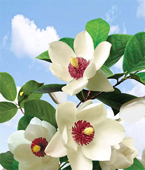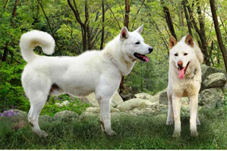In general, a symbol of a country refers to its official hallmark distinguished from other countries.
In September last year, the DPRK published “Symbols of the DPRK”, a book which introduces its symbols in a comprehensive way.
The book, which consists of ten chapters and an appendix, introduces in detail the general knowledge about the symbols of the DPRK, international standards to select national symbols and actual situation and their biological features. It also contains symbols of some countries around the world.
The full name of the DPRK is the Democratic People’s Republic of Korea. It means that it is a genuine country of people where the popular masses are the independent motive force of history and the masters of the country and that a democratic country which serves the interests of broad masses of working people should be built.
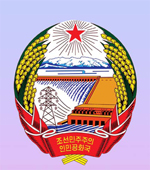 The national emblem of the DPRK depicts a gigantic hydroelectric power station below Mt Paektu, the sacred mountain of the Korean revolution over which a five-pointed red star shines, with ears of rice forming an oval frame and bound with a red ribbon bearing the inscription, “The Democratic People’s Republic of Korea.”
The national emblem of the DPRK depicts a gigantic hydroelectric power station below Mt Paektu, the sacred mountain of the Korean revolution over which a five-pointed red star shines, with ears of rice forming an oval frame and bound with a red ribbon bearing the inscription, “The Democratic People’s Republic of Korea.”As an official hallmark of the DPRK, the glorious fatherland of all the Korean people, it symbolizes its dignity and sovereignty, invincible might and prosperity.
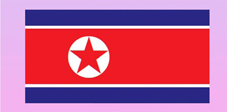 The national flag of the DPRK is a rectangular, blue-and-red flag. (The ratio of the length to the width is 1:2.) It has a wide red panel in the centre, which is symmetrically bordered above and below by two thin white stripes and two blue stripes, and a five-pointed red star within the white circle near the hoist.
The national flag of the DPRK is a rectangular, blue-and-red flag. (The ratio of the length to the width is 1:2.) It has a wide red panel in the centre, which is symmetrically bordered above and below by two thin white stripes and two blue stripes, and a five-pointed red star within the white circle near the hoist.The national anthem of the DPRK is the Patriotic Song, which consists of 201 Korean letters. Created in Juche 36 (1947), it is an all-people hymn which reflects the national dignity and self-respect of the Korean people advancing vigorously towards the future in close unity with one mind behind their leader, their ardent love for the country and their unshakable will to add eternal lustre to their prospering country.
The vernacular of the DPRK is the Korean language. It is an alphabetic language with 19 consonants and 21 vowels. This language peculiar to the Korean nation has been perfected and systematized into an excellent linguistic structure through protracted period of historical development. The Pyongyang dialect is the standard of the Korean language.
The national flower of the DPRK is magnolia. Its peony-shaped, big and white flowers and red-coloured ripened fruits fall into chime with each other on fresh and green leaves. The flower is a simple variety and grows in all parts of Korea except some areas in the northern tableland. Its beauty and fragrance give delight to the people and its luxuriant foliage invigorates them.
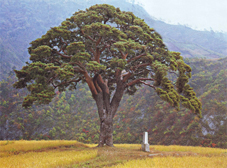
The national tree of the DPRK is the pine tree. From olden times, the Korean people were very fond of the tree for its evergreen foliage. The tree represents the soul and spirit of their nation and their sentiment and feelings. As a species that originated in Korea, it takes the lion’s share of distribution and population among the forest trees in the country.
The national dog of the DPRK is the Phungsan dog. The home of the dog is the area of Kim Hyong Gwon County (it was called Phungsan in the past) in Ryanggang Province in the alpine region. The
Phungsan is clever, nimble and good-natured, and follows its master meekly at ordinary times. But it fights its rival to the end. It is an endemic dog in Korea which has developed along with its history spanning thousands of years. It has been registered as a natural living monument to preserve the pure breed.
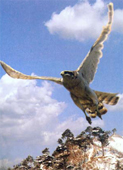 The national bird of the DPRK is the Eurasian goshawk (Accipiter gentiles). From ancient times, the Korean people tamed the agile and intrepid goshawk and used it in hunting pheasants, hares and other animals.
The national bird of the DPRK is the Eurasian goshawk (Accipiter gentiles). From ancient times, the Korean people tamed the agile and intrepid goshawk and used it in hunting pheasants, hares and other animals. The national liquor of the DPRK is the Pyongyang Liquor much favoured by ordinary people. Distilled at the Taedonggang Foodstuff Factory, the liquor has been awarded the February 16 Sci-tech Prize, the top sci-tech prize in the country, and the December 15 High-quality Medal, a medal for the top local products.
The national liquor of the DPRK is the Pyongyang Liquor much favoured by ordinary people. Distilled at the Taedonggang Foodstuff Factory, the liquor has been awarded the February 16 Sci-tech Prize, the top sci-tech prize in the country, and the December 15 High-quality Medal, a medal for the top local products.
 The national emblem of the DPRK depicts a gigantic hydroelectric power station below Mt Paektu, the sacred mountain of the Korean revolution over which a five-pointed red star shines, with ears of rice forming an oval frame and bound with a red ribbon bearing the inscription, “The Democratic People’s Republic of Korea.”
The national emblem of the DPRK depicts a gigantic hydroelectric power station below Mt Paektu, the sacred mountain of the Korean revolution over which a five-pointed red star shines, with ears of rice forming an oval frame and bound with a red ribbon bearing the inscription, “The Democratic People’s Republic of Korea.” The national flag of the DPRK is a rectangular, blue-and-red flag. (The ratio of the length to the width is 1:2.) It has a wide red panel in the centre, which is symmetrically bordered above and below by two thin white stripes and two blue stripes, and a five-pointed red star within the white circle near the hoist.
The national flag of the DPRK is a rectangular, blue-and-red flag. (The ratio of the length to the width is 1:2.) It has a wide red panel in the centre, which is symmetrically bordered above and below by two thin white stripes and two blue stripes, and a five-pointed red star within the white circle near the hoist.
 The national bird of the DPRK is the Eurasian goshawk (Accipiter gentiles). From ancient times, the Korean people tamed the agile and intrepid goshawk and used it in hunting pheasants, hares and other animals.
The national bird of the DPRK is the Eurasian goshawk (Accipiter gentiles). From ancient times, the Korean people tamed the agile and intrepid goshawk and used it in hunting pheasants, hares and other animals. The national liquor of the DPRK is the Pyongyang Liquor much favoured by ordinary people. Distilled at the Taedonggang Foodstuff Factory, the liquor has been awarded the February 16 Sci-tech Prize, the top sci-tech prize in the country, and the December 15 High-quality Medal, a medal for the top local products.
The national liquor of the DPRK is the Pyongyang Liquor much favoured by ordinary people. Distilled at the Taedonggang Foodstuff Factory, the liquor has been awarded the February 16 Sci-tech Prize, the top sci-tech prize in the country, and the December 15 High-quality Medal, a medal for the top local products.
